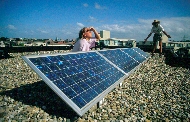|
|
                    
Ein
erster paar (ein)blicken
Update
with new data for December 2009 -
preliminary status 2009 as a whole
A first insight in Germany's market growth in photovoltaics in 2009
Voorlopige
cijfers ontwikkeling fotovoltaïsche markt en zonnestroom productie
2009 in Duitsland
For
dynamic graphics on Germany's record breaking year 2009, please also visit
the
2009 graphics page
on Polder PV!
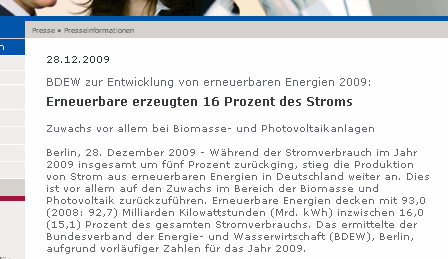
©
BDEW
Introductie/Introduction
Grafieken/Graphs
BNA (PV-capacity Germany 2009)
BDEW
(PV-production Germany up till 2009)
Links
BRD
PV-marktanalyses
2012 2010
2008 2007
definitief 2007 cf. BSW
2006 2005
Introductie/Introduction
Op deze
pagina een eerste inzage in de realisatie van hernieuwbare elektriciteit
inclusief zonnestroom in Duitsland in 2009, volgens cijfers van zowel
de BDEW als de BNA, beiden ambtelijke organisaties onder het Bundeswirtschaftsministerium
in Duitsland die de progressie op het vlak van (hernieuwbare) energie
nauwlettend in de gaten moeten houden en die zeer regelmatig spectaculaire
cijfers presenteren in fascinerende overzichten. Update:
10 april 2010 n.a.v. publicatie van december 2009 data door het BNA op
9 april 2010.
On
this web page the first (not yet validated) data for PV-market progression
in Germany are presented for 2009 on basis of the data published by the
Bundesnetzagentur, BNA (PV-capacity in MWp, update
up till december 2009 published April 9, 2010) and the Bundesverband der
Energie- und Wasserwirtschaft, BDEW (production of solar electricity and
other renewable sources under the EEG Law conditions). Graphs made by
Peter J. Segaar/Polder PV, Leiden (NL). See Graphs for BNA
data and BDEW data, respectively. For
use of graphs, please contact
webmaster of Polder PV. On this webpage, English explanations can
be found directly below the graphs.
Important!
Note that in all the graphs and captions on this web-page
the "European" type of decimal/comma
separation is being used! Hence, "2.000" reads
as "two-thousand" (alternatively used anglosaxon notation: "2,000").
"7,25 kWp" reads as "seven point twenty-five kWp"
(= 7.250 Wattpeak; anglosaxon notation: "7.25 kWp" or "7,250
Wp")! See also discussion on Wikipedia "Decimal
Separator" (Polder PV never has used the "space" in
long numbers, hence not "2 000 000", but "2.000.000"
to denote one million or 2 times ten power 6, 2 "mega").
BNA
De cijfers voor de progressie in bij het Bundesnetzagentur aangemelde
zonnestroom capaciteit (MWp) voor 2009 (een verplichting
sinds de EEG Novelle tot geldige Wet werd op 1 januari 2009, om aanspraak
op de wettelijke invoedingstarieven te kunnen maken) werden tot en met
de maand september 2009 reeds
in oktober gepubliceerd. Deze waren nodig om vast te kunnen stellen
hoe groot de "marktgroei van het voorafgaande jaar" was geweest.
Op basis van deze vaststelling werden namelijk afhankelijk van het bereikte
"marktgroeicorridor" de degressie percentages per 1 januari
2010 vastgesteld. Zoals al lang was verwacht, werd de hoogste groei met
de vingers in de neus bereikt. Uiteindelijk volgens Photon een spectaculaire
minimaal 1.933 MWp voor het kalenderjaar
2009. BNA ging uit van de eerste 9 maanden van 2009 en de laatste drie
maanden van 2008 (wettelijk voorgeschreven), maar dat kwam feitelijk op
hetzelfde neer. Dientengevolge werden de degressiepercentages dus maximaal
opgeschoefd zoals in de EEG Novelle 2009 voorgeschreven. Zie de korte
bespreking van
1 november 2009, en natuurlijk de nieuwe grafiek
en tabel op de
EEG pagina van Polder PV.
Duidelijk
al was aan die in oktober 2009 gepubliceerde eerste - nog niet gevalideerde,
en mogelijk nog met de nodige "fouten" gezegende - data voor
2009, dat Duitsland alle marktgroei cijfers zou gaan verpletteren. In
januari 2010 vond ik op de BNA site een separate nieuwe spreadsheet voor
alleen de maand oktober 2009. Begin februari 2010 volgden de resultaten
voor november 2009. En tot slot, op 9 april 2010 werden de "voorlopige"
resultaten voor de laatste maand, december 2009 gepubliceerd. Elke keer
waren de resultaten verbijsterend en de getallen duizelingwekkend. Wat
nogal wat "belooft" voor de cijfers voor 2010, want ook dat
jaar gaat in Duitsland spectaculair worden, is de verwachting. Zie de
grafieken verderop op deze pagina.
BDEW
Voor een uitgebreide toelichting van de BDEW data voor de (kWh) productie
van hernieuwbare stroom, zie mijn artikel
van 11 januari 2010. De cijfers van BDEW werden gepubliceerd op 28
december 2009. Het cijfer voor 2009 moet (ook) nog worden gevalideerd
en kan nog worden bijgesteld. Heel veel veranderen zullen die cijfers
waarschijnlijk niet. Overige cijfers (eerdere jaren) zijn definitief en
afkomstig van door accountants geaccordeerde jaarrapporten. Polder PV
berekende een deel van de weergegeven cijfers uit de data in het persbericht
pdf van BDEW (Excel spreadsheet, afrondingsfouten kunnen voorkomen). En
maakte van de resultaten een serie grafieken. Zie de aparte
sectie voor de BDEW resultaten op deze pagina.
Grafieken/Graphs
UPDATE: December 2009
(1)
Grafieken BNA data/Graphs made from BNA data
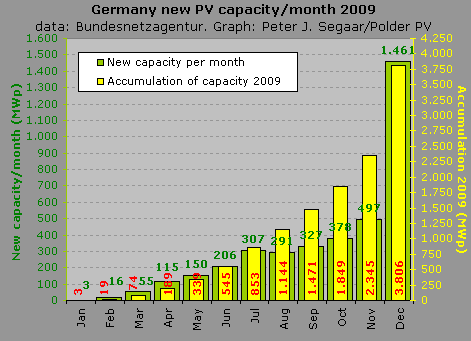
All
data in this section from Bundesnetzagentur (FRG).
Graphs made by Peter J. Segaar/Polder
PV, Leiden (NL).
Graph
BNA 1 - Accumulation of new PV-capacity installed in monthly
growth (MWp, left Y-axis, green columns) in Germany in
2009. In addition, the total accumulation for the whole year is presented
in yellow columns, belonging tot the right Y-axis. Growth remains staggering
and unprecedented. Year accumulation from January up till December 2009
has been 3.806 MWp. Numbers
not yet definitive and probably not yet taking into account many "missing"
(or twice-counted) installations in the - preliminary - BNA database...
Grafiek
BNA 1 - Accumulatie van nieuw geïnstalleerde PV capaciteit
in de vorm van maandelijkse groei (MWp, linker Y-as,
groene kolommen) in Duitsland in 2009. Tegelijkertijd wordt de accumulatie
voor het gehele jaar weergegeven in gele kolommen, data op de rechter
Y-as. De groei is verbijsterend en nooit eerder vertoond. De jaar accumulatie
van januari tot en met december 2009 was 3.806
MWp. Mogelijk nog niet eens de vele "missende"
(maar ook mogelijk: dubbel getelde) installaties in de - voorlopige -
BNA database meetellend...
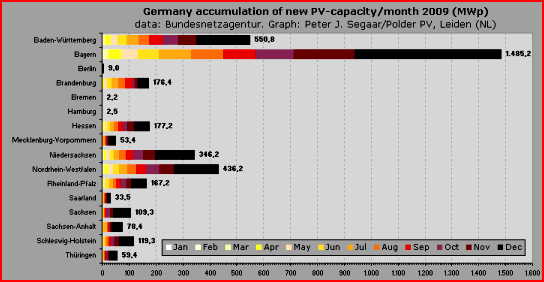
CLICK on
graph for enlargement
X-axis: MWp accumulated per Bundesland in 2009.
Capacity given in number is the end of year capacity newly installed in
2009 per Bundesland.
Graph
BNA 2 - Accumulation of new PV-capacity in Germany split
into the contributions of the different Bundesländer (the so-called
city states of Berlin, Bremen and Hamburg included). Each month has been
given its own colour code. The enormous growth in the sunny 2 southern
states (in particular Bavaria/Bayern - in December 1.485,2 MWp; Baden-Württemberg
"only" at 550,8 MWp) is apparent. The heavily industrialized
and populated Nordrhein-Westfalen state straddling the eastern part of
the Netherlands follows suit (436,2 MWp). The less populated west-German
state of Niedersachsen (north of NRW) is on the fourth position (346,2
MWp). Brandenburg (176,4 MWp), the only former east-German state with
considerable growth relative to its much richer "western" counterparts,
has an active policy for realising large free-field installations such
as the 53
MWp Lieberose installation (CdTe First Solar project by juwi).
Grafiek
BNA 2
- Accumulatie van nieuwe PV-capaciteit in Duitsland gesplitst in de bijdragen
van de verschillende deelstaten (Bundesländer, de zogenaamde stad-staten
Berlijn, Bremen en Hamburg incluis). Elke maand heeft zijn eigen kleurcode
gekregen. De enorme groei van de 2 zonnige zuidelijke staten (vooral Bayern
in december 1.485,2 MWp geaccumuleerd; Baden-Württemberg "slechts"
550,8 MWp) is duidelijk. De zwaar geïndustrialiseerde, dichtbevolkte,
aan oost Nederland grenzende deelstaat Nordrhein-Westfalen ligt niet ver
achter (436,2 MWp). De minder dicht bevolkte west-Duitse deelstaat Niedersachsen
(noordelijk van NRW) ligt op de vierde plaats (346 MWp). Brandenburg (176,4
MWp), de enige voormalige oost-Duitse deelstaat met forse groei t.o.v.
hun veel rijkere "westelijke" evenknieën, heeft een actieve
politiek om grote vrije veld installaties te realiseren, zoals het 53
MWp Lieberose park (CdTe First Solar dunnelaag project gerealiseerd
door juwi).
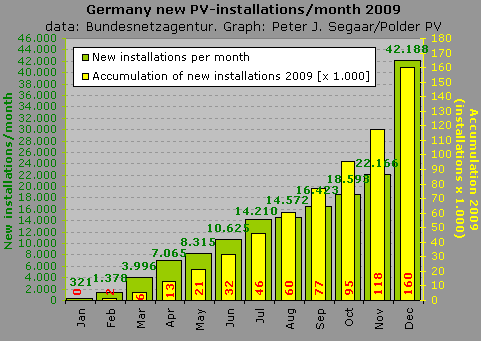
Graph
BNA 3 - Comparable to Graph BNA 1, but this time not capacity
accumulation, but number of installations reported to BNA. In green, again
(left Y-axis), monthly accumulation, with a record of 42.188 new PV-systems
in December 2009 only. Total number of new installations for the year
2009, yellow columns (right Y-axis), increased to a staggering 159.852
new installations at the end of the year (rounded at 160 times 1.000 in
the graph). Truly the most democratic form of producing relatively predictable,
reliable renewable electricity during the day in a way that is almost
impossible to sabotage, reducing risks for part of the energy production.
Also: stimulating a large part of the population to think about distributed
energy production and local energy consumption - and of course, act upon
the revolution that our society so desperately needs as their proud fellow
citizens already have done.
Grafiek
BNA 3 - Vergelijkbaar met grafiek BNA 1, maar ditmaal
niet capaciteit accumulatie maar het aantal installaties zoals gerapporteerd
aan het BNA. In groen wederom (linker Y-as), de maandelijkse accumulatie,
met een record aantal van 42.188 nieuwe PV-systemen alleen al in december
2009. Het totale aantal geaccumuleerde nieuwe installaties voor heel 2009,
weergegeven in gele kolommen (rechter Y-as), was aan het eind van het
jaar al opgelopen tot een enorme hoeveelheid van 159.852 stuks (in de
grafiek afgerond tot 160 x 1.000). Zonder meer de meest democratische
vorm van de productie van relatief voorspelbare, betrouwbare hernieuwbare
elektriciteit gedurende de dag op een wijze die vrijwel onmogelijk is
te saboteren, daarbij risico's verminderend voor een gedeelte van de energievoorziening.
Daarbij ook een groot deel van de bevolking stimulerend om na te denken
over de gedistribueerde vorm van energie opwekking en lokale energie consumptie
- en natuurlijk om (ook) in actie te komen middels de energie revolutie
die onze samenleving zo hard nodig heeft. Zoals hun trotse, reeds PV-installaties
bezittende landgenoten hebben gerealiseerd.
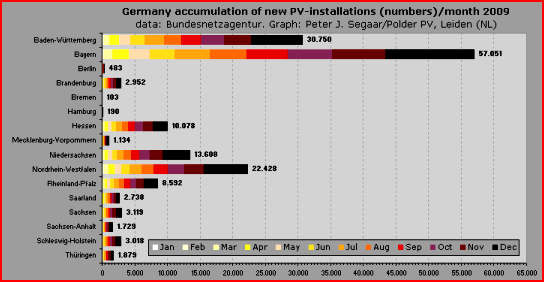
CLICK
on graph for enlargement
X-axis: number of new installations accumulated per Bundesland in 2009.
Numbers at the right
of the columns indicate the total number of new installations in 2009
at the end of the year per Bundesland.
Graph
BNA 4 - Comparable to Graph BNA 2, but again, in this
graph with the number of installations reported to BNA split up per Bundesland.
The total number of installations accumulated in Bavaria (Bayern) increased
to a "respectable" 57.051, only in the year 2009.
Grafiek
BNA 4 - Vergelijkbaar met grafiek BNA 2, maar wederom,
in dit exemplaar met het aantal installaties zoals opgegeven aan en verwerkt
door het BNA opgesplitst per deelstaat. De totale hoeveelheid nieuwe installaties
wat in 2009 is bijgebouwd/aangemeld bij BNA was in alleen al de deelstaat
Beieren opgelopen tot een "respectabele" hoeveelheid van 57.051
PV-systemen.
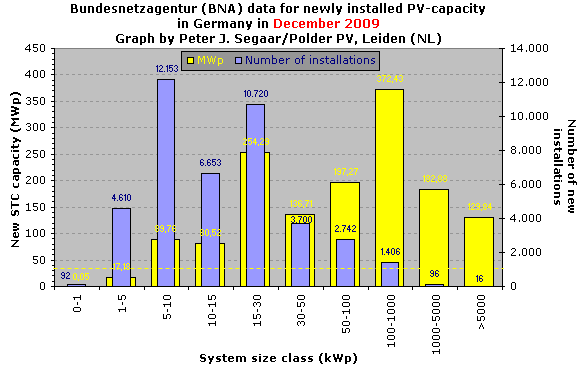
Graph
BNA 5A - December 2009: new number of installations
per selected kWp category in blue (scale at right Y-axis), and MWp capacity
cumulated in the same categories in yellow (scale at left Y-axis). Note
big differences with respect to MWp distribution among installation classes
as compared to the previous two months (interactive graph BNA 5B below,
note: different scales for Y-axis!). The category with installations larger
than 5 MWp (16 of them) already had 130 MWp, together with the category
> 1 MWp 313 MWp had been installed in 112 large installations. Average
installation size in the total new pool for December 2009 was 34,63 kWp
(dashed yellow line, Y-axis should be read in "kWp" instead
of "MWp" in that case).
Grafiek
BNA 5A - December 2009: het nieuwe aantal PV-installaties
per geselecteerde kWp categorie in blauw (rechter Y-as), en de gecumuleerde
nieuwe MWp capaciteit per categorie in die maand in geel (linker Y-as).
Let op de grote verschillen m.b.t. de verdeling van de MWp accumulaties
binnen de diverse installatie categorieën, vergeleken met die van
de voorgaande twee maanden (interactieve grafiek BNA 5B verder hier onder,
let op: verschillende schalen voor de Y-as!). De categorie met installaties
groter dan 5 MWp (16 stuks) had al 130 MWp, samen met de categorie >
1 MWp omvatten die twee grootste categorieën al 313 MWp met 112 grote
installaties. De gemiddelde installatie grootte in de nieuwe december
2009 "pool" was 34,63 kWp (gele streepjeslijn, waarbij de Y-as
i.p.v. "in MWp" als "in kWp" gelezen dient te worden).
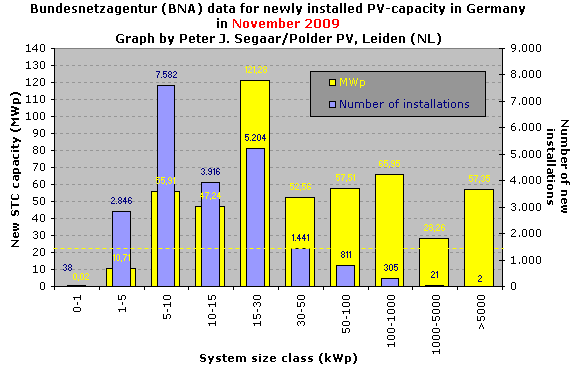 ^^^ ^^^
ROLL-OVER IMAGE (move mouse pointer over graph to reveal
the previous October 2009 update)
Graph
BNA 5B - In the basic graph visible I made a split of
the BNA data for November 2009 only. The split is into system categories
to visualize where the largest number of installations and where most
MWp capacity is concentrated. The category listing is in the X-axis (in
kWp/installation). Note that in the unprecedented and detailed German
feed-in rate system ("Einspeise Vergütung") there are major
breaks at the levels up till 30 kWp, 30 - 100 kWp, 100 kWp - 1 MWp, and
bigger than 1 MWp (with free-field installations a separate tariff, see
table).
At
first, the graph shows clearly that the largest number of installations
(blue columns, right Y-axis) typically fall into the 5 - 10 kWp range
characteristic of the German private market (roof-filling PV-systems of
high quality), and that there is a second maximum in the 15 - 30 kWp range.
The latter is the "highest section" with the best feed-in rate
per kWh (newly installed in 2009 20+ years 43,01 eurocent/kWh for all
electricity fed into the lowest grid level). Many of this type of installations
are designed such that they fall in the "max. 30 kWp" range,
many of them are placed on farmer's barns, on school roofs, etc. Beyond
that important "first barrier", the number of installations
drops off sharply. Note that there is also a highly interesting - although
very small - range of minute installations in Germany, with a system size
of 1 kWp or less. Very little is known about this "untypical German"
category of net-integrated "micro-systems". I separated this
category because of the typical market conditions in my home-country,
the Netherlands, where evolution of PV is extremely slow and many small
systems have been - and still are being - realized.
With
respect to system capacity distributed among the (artificial) installation
segmentation I made (yellow columns, left Y-axis) the "weight"
is, for who is adjusted to German reality, of course, shifted to the right
in the graph. Here, most capacity (MWp) has been installed in the 15-30
kWp installation category (accumulated to 121 MWp in November 2009), while,
in addition, there is a rather uniform further contribution over the -
artificial - categories of 30-50, 50-100, and 100-1.000 kWp. The category
1.000-5.000 kWp/installation has one of the lowest impacts on total capacity
installed, although 28 MWp were added by only 21 installations.
In
October 2009 (move mouse pointer over the graph) there was only one installation
in the highest category > 5 MWp: a 7.273,5 kWp PV-system in Doberschütz,
Sachsen, included on October 27, 2009, in the BNA database. November introduced
two new monsters in this category: 6,36 MWp Thiersheim in north-eastern
Bavaria (near the Czech border) added on November 18, 2009. And the super
parc Straßkirchen in eastern Bavaria (west of Deggendorf), included
in the BNA statistics two days later on November 20 with a one-time 50,99
MWp. This parc is a typical example of a "vertical integration"
strategy since it has modules made entirely of products from the former
"pure solar cell player", east-German Q-Cells.
From
the database I also calculated the average installation
size of all November 2009 entries. It amounted to 22,41
kWp per PV-system (yellow dashed line in the graph; Y-axis
should be read in "kWp" instead of "MWp" in that case).
Again higher as the 20,32 kWp average of the installations in the previous
month...
For
december 2009 graph, see figure above.
Grafiek
BNA 5 - In de basisgrafiek maak ik een opsplitsing voor
uitsluitend de data voor november 2009. De splitsing betreft een herverdeling
van de bij het BNA aangemelde PV-systemen over categorieën om zichtbaar
te maken waar de grootste concentraties aan aantallen en totaal opgesteld
vermogen zijn terug te vinden. De categorie indeling is zichtbaar onder
de X-as (in kWp/installatie). Let op dat in het unieke en gedetailleerde
Duitse invoedingstarief systeem ("Einspeise Vergütung")
er belangrijke grenzen zijn tussen systemen tot en met 30 kWp, 30 - 100
kWp, 100 kWp - 1 MWp, en groter dan 1 MWp (met vrije veld installaties
een apart tarief, zie de tabel).
Ten eerste
toont de grafiek duidelijk dat het grootste aantal nieuwe installaties
(blauwe kolommen, rechter Y-as) vanzelfsprekend valt in he 5 - 10 kWp
traject wat karakteristiek is voor de Duitse particuliere markt (dakvullende
PV-systemen van hoge kwaliteit), en dat er een tweede maximum ligt in
het 15- 30 kWp traject. De laatste is het "hoogste niveau" met
de beste invoedingstarieven per kWh (nieuw geïnstalleerd in 2009
20+ jaar 43,01 eurocent/kWh) voor alle stroom die op het laagste net-niveau
wordt ingevoed). Veel van dit soort installaties worden zodanig ontworpen
dat ze in de "maximale 30 kWp" range vallen, veel ervan geplaatst
op boerenschuren, op schooldaken, etc. Voorbij deze "eerste barrière",
valt het aantal installaties sterk naar beneden. Let op dat er ook een
zeer interessante - ofschoon zeer kleine - categorie van minuscule installaties
is in Duitsland, met een systeemgrootte van maximaal 1 kWp. Zeer weinig
is er bekend van deze "ontypisch Duitse" categorie van netgekoppelde
"micro-systemen". Ik heb deze categorie bewust afgesplitst vanwege
de typische marktomstandigheden in Nederland, waar de evolutie van PV
extreem traag blijft gaan en er zeer veel kleine systemen zijn - en nog
steeds worden - geplaatst.
Met betrekking
tot de systeem capaciteit die is terug te voeren op de (kunstmatige) installatie
segmentatie die ik heb gemaakt (gele kolommen, linker Y-as) is het zwaartepunt
voor diegenen die vertrouwd zijn met de Duitse realiteit uiteraard verschoven
naar de rechterzijde van de grafiek. Hier is de meeste geïnstalleerde
capaciteit (MWp) te vinden in de categorie 15-30 kWp (al 121 MWp totaal
geaccumuleerd in november 2009), terwijl daar bovenop er een redelijk
uniforme (hoge) verdeling is over de - kunstmatige - categorieën
30-50, 50-100, en 100-1.000 kWp. De categorie 1.000-5.000 kWp/installatie
heeft een relatief geringe impact op de totale geïnstalleerde capaciteit,
alhoewel er 28 MWp werd toegevoegd door slechts 21 installaties.
In oktober
(beweeg muiswijzer over de grafiek) was er slechts een grotere installatie
in de hoogste categorie > 5 MWp: een 7.273,5 kWp systeem in Doberschütz,
Sachsen, in de BNA database opgenomen op 27 oktober 2009. November introduceerde
twee nieuwe monsters in deze categorie: 6,36 MWp Thiersheim in noordoost
Beieren (nabij de grens met Tsjechië) toegevoegd op 18 november 2009.
En het super park Straßkirchen in oost Beieren (westelijk van Deggendorf),
2 dagen later opgenomen in de BNA statistieken op 20 november met een
unieke 50,99 MWp. Die installatie is een typisch voorbeeld van een "vertikale
integratie" strategie omdat het modules betreft die volledig uit
producten van een nog niet zo lang geleden vrijwel "pure cellen fabrikant"
betreft: het in Thalheim bij Leipzig gevestigde oost-Duitse Q-Cells.
Uit de
gegevens van het BNA kon ik ook de gemiddelde installatiegrootte
van alle november 2009 systemen berekenen. Het was een
verbijsterende 22,41 kWp
per PV-systeem (gele gestreepte lijn in de grafiek, waarbij de Y-as i.p.v.
"in MWp" als "in kWp" gelezen dient te worden). Wederom
hoger dan het 20,32 kWp gemiddelde van de installatiegrootte in de voorgaande
maand...
Voor
de december 2009 grafiek, zie de figuur hierboven.
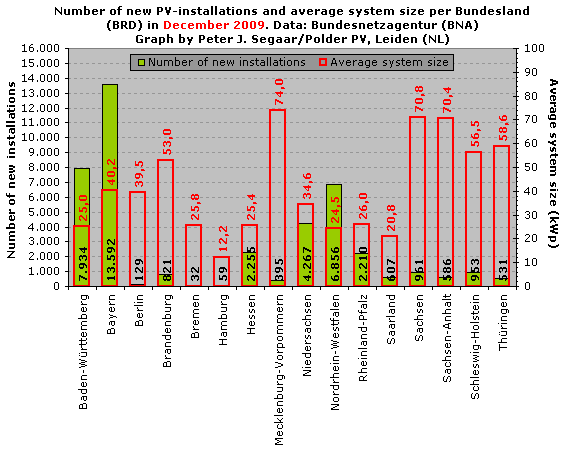
Graph
BNA 6A
- December 2009 graph with new installations per Bundesland in green columns
(left Y-axis), and the average installation size in red "empty"
columns (right Y-axis). Big differences with the results for the previous
two months, see the interactive graph BNA 6B further below (with extra
explanation, note: different scale for Y-axis).
Grafiek
BNA 6A - December 2009 grafiek met de nieuwe installaties
per Bundesland in groene kolommen (linker Y-as), resp. de gemiddelde installatiegrootte
in roodomlijnde "lege" kolommen (rechter Y-as). Grote verschillen
met de voorgaande twee maanden, zie interactieve grafiek BNA 6B verderop
(met verdere toelichting, let op de afwijkende schaal voor de Y-assen).
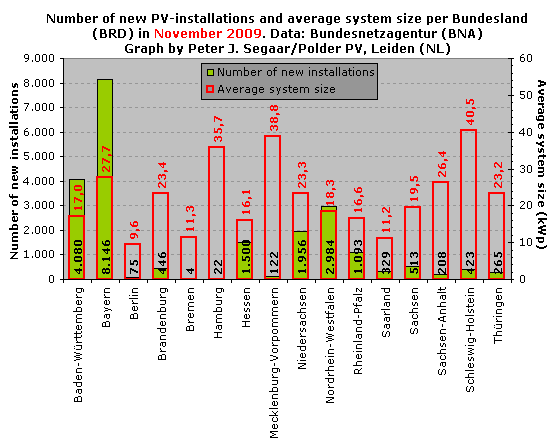
^^^
ROLL-OVER IMAGE (move mouse pointer over graph to reveal
the previous October 2009 update
Graph
BNA 6B - Finally, in this last BNA graph the number of
installations and the average system size is presented in a second roll-over
image for the months October and November 2009, respectively (move mouse
pointer to choose between the 2 graphs). Again, I made a split into the
contributions for the different Bundesländer in Germany. With respect
to the number of installations (green columns, left Y-axis), Bavaria and
Baden-Württemberg, Germany's most southern states remain the champions
with 6.851/8.146 (Oct./Nov.), and 3.527/4.080 (Oct./Nov.) new entries,
respectively. However, when we look to the average system size per Bundesland
(open red-lined columns, right Y-axis), a whole different "picture"
emerges. In October 2009, four other "Bundesländer" take
the lead. They are the city state of Bremen (44,2 kWp/installation), the
East German state of Sachsen (39,3 kWp/installation), the most Northern,
sunny coastal state of Schleswig-Holstein (38,6 kWp/installation), and
East German Thüringen (32,8 kWp/installation), respectively. However,
in November the general picture again changes dramatically, with Schleswig-Holstein
taking the lead (40,5 kWp/installation!), followed by Mecklenburg-Vorpommern
(38,8 kWp/installation), and that "other" city-state, Hamburg,
on the third position (35,7 kWp/installation).
The average system
size, of course, can be considerably influenced by a few (very) large
installations in states with not too many new intallations in the period
analysed. Bremen had only ten new PV-installations in October 2010 reported
to BNA. The biggest of them was a 299,16 kWp system that heavily influenced
the outcome for this small region (the other 9 installations had an average
of only 15,9 kWp...). Hamburg had only 22 new installations reported
in November 2009, but the three largest systems, 89,225, 105,74, and even
500 kWp, had a big impact on the "state's" average per system
incorporated in the BNA database in that month.
It is evident
that the monthly average per "Land" can fluctuate considerably,
depending on the monthly growth, the number of installations newly reported,
and the not too many occasions in which a (very) large PV-system is included
in the monthly accumulation at BNA. Only in states with high growth in
number and capacity of installations, the fluctuation of the average new
system size will be much lower.
Grafiek
BNA 6 - Tot slot geef ik in de laatste grafiek het aantal
installaties en de gemiddelde systeemgrootte weer in een tweede "roll-over
image" voor de maanden oktober resp. november 2009 (muiswijzer over
het plaatje bewegen om te kiezen tussen de 2 grafieken). Wederom splitste
ik de bijdrages per deelstaat in Duitsland. Met betrekking tot het aantal
installaties (groene kolommen, linker Y-as) blijven Beieren en Baden-Württemberg,
Duitsland's twee zuidelijkste deelstaten de kampioenen, met 6.851/8.146
(okt./nov.), resp. 3.527/4.080 (okt./nov.) nieuwe opgaves. Kijken we echter
naar de gemiddelde systeemgrootte per deelstaat (open rood-omlijnde kolommen,
rechter Y-as), ziet het er weer heel anders uit en gaan er in oktober
2009 vier andere deelstaten aan de leiding. Dat waren achtereenvolgens
de stadstaat Bremen (44,2 kWp/installatie), de oost-Duitse deelstaat Sachsen
(39,3 kWp/installatie), de meest noordelijk gelegen zonnige, aan Noord-
en Oostzeekust gelegen deelstaat Schleswig-Holstein (38,6 kWp/installatie),
en het oost-Duitse Thüringen (32,8 kWp/installatie). In november
echter, ziet het algehele plaatje er weer heel anders uit, met Schleswig-Holstein
ditmaal aan de leiding (40,5 kWp/installatie!), gevolgd door Mecklenburg-Vorpommern
(38,8 kWp/installatie), en die "andere" stads-staat, Hamburg,
op de derde positie (35,7 kWp/installatie).
De gemiddelde
systeemgrootte kan uiteraard door slechts enkele (zeer) grote installaties
in deelstaten met niet al te veel nieuwe systemen worden beïnvloed
in de geanalyseerde periode. Bremen had slechts tien nieuwe PV-installaties
die voor oktober 2009 bij het BNA waren aangemeld. De grootste daarvan
was een 299,16 kWp installatie die zwaar zijn stempel op het eindresultaat
voor deze kleine regio heeft gedrukt (de andere 9 opgegeven PV-systemen
hadden een gemiddelde grootte van slechts 15,9 kWp). Hamburg had in november
2009 slechts 22 nieuwe installaties aangemeld. De drie grootste systemen,
89,225, 105,74, en zelfs 500 kWp, hadden een grote invloed op het gemiddelde
van de PV-installaties in het "land" zoals die waren verwerkt
in de database van het BNA.
Het is
duidelijk dat het maandelijkse gemiddelde per deelstaat fors kan fluctueren,
afhankelijk van de maandelijkse groei, het aantal opgegeven nieuwe systemen,
en de schaarse gevallen dat een (zeer) grote PV-installatie binnen de
maandelijkse accumulatie cijfers van het BNA zal gaan vallen. Alleen in
staten met een hoge groei in aantallen en totaal vermogen aan installaties,
zal de fluctuatie in de gemiddelde installatiegrootte binnen de perken
blijven.
(2)
Grafieken BDEW data/Graphs made from BDEW data
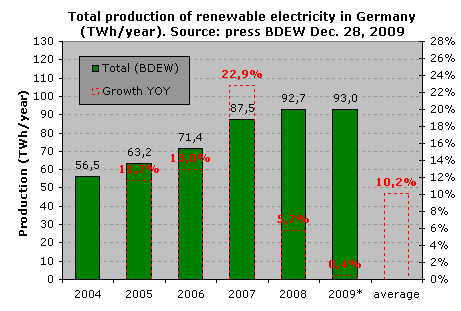
All
data in this section from BDEW. Graphs made by Peter J. Segaar/Polder
PV, Leiden (NL).
Graph
BDEW 1 - Tota production of renewable electricity in Germany
from 2004 up till 2009 in TWh/year (1 TWh = one thousand billion kWh =
1.000.000.000 kWh = 10 times 10 power 9 kWh = 10 times 10 power 12 Wh).
In dark green (columns) the physical production of electricity legally
claimed under the strict EEG conditions according to BDEW data. Red dashed
columns illustrate the growth in production as compared to the previous
year. After a record growth in the years 2006-2007 growth fell back considerably
(among others resulting from the economic crisis, hence meagre new capacity
realisation, leading to little growth in newly produced green kWh), but
it still remained at a positive 0,4% level in 2008-2009. Average in the
period 2004-2009 was a healthy 10,2% a year. The ultimate - albeit not
yet validated - production in 2009 was already 93,0 TWh, the yearly production
of over 23 nuclear facilities such as the old Dutch Borssele plant (yearly
production app. 4 TWh).
Grafiek
BDEW 1 - Totale productie van hernieuwbare elektriciteit
in Duitsland van 2004 tot en met 2009 in TWh/jaar (1 TWh = 1 miljard kWh).
In donkergroen (kolommen) de fysieke productie van onder het EEG vallende
elektriciteit volgens BDEW. Rood gestippeld geeft de groei in productie
weer t.o.v. het voorafgaande jaar. Na een record groei van 2006-2007 stortte
de groei fors in (o.a. door economische crisis en dus zeer beperkte nieuwe
capaciteit realisatie, leidend tot weinig groei in opgewekte nieuwe kWh),
maar bleef in 2008-2009 nog steeds net positief met 0,4%. Gemiddelde over
2004-2009 was nog steeds een uitermate gezonde 10,2% per jaar. Uiteindelijke
(nog te valideren) productie in 2009 was al 93,0 TWh, de jaarproductie
van ruim 23 Borssele kerncentrales...
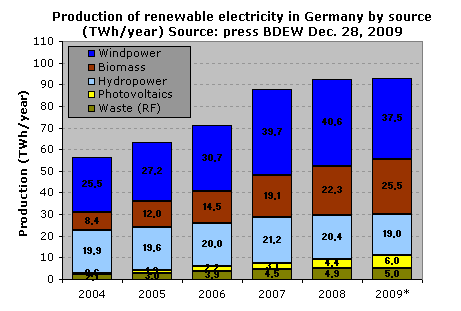
(RF = renewable
[biomass] fraction of several waste inputs)
Graph
BDEW 2 - as in graph 1, but now the columns are split
up in the separate shares of 5 renewable electricity generating options.
Watch the strong growth of the sources solar electricity (yellow) and
biomass (brown). Voor more detailed (Dutch) explanation with this graph,
see the original article
of January 11. 2010.
Grafiek
BDEW 2 - als in grafiek 1, maar nu de kolommen opgesplitst
in de afzonderlijke aandelen van 5 hernieuwbare stroom producerende opties.
Let op de forse groei in de bronnen zonnestroom (geel) en biomassa (bruin).
Voor uitgebreidere toelichting bij deze figuur, zie in het oorspronkelijke
artikel van
11 januari 2010.
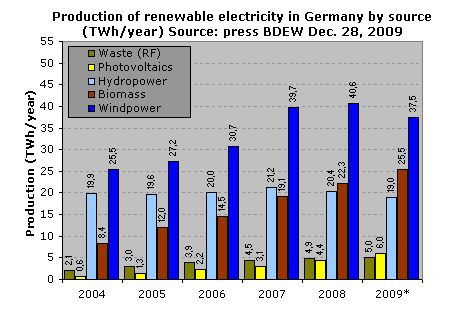
Graph
BDEW 3 - comparable graph like in BDEW 2, but now with
the different options split and placed alongside each other to better
evaluate the ratio between the options. Solar electricity still has a
relatively low impact, but it already has grown to 6 TWh/year (one time
and a half the production of Dutch nuclear reactor Borssele), it is growing
fast, has a lot of potential, and already in 2009 it passed the total
output of production from (the biogenic fraction from) waste. Windpower
has been producing slightly less by a combination of relatively low wind
conditions and "repowering" because of which several older wind
parks have been put out of operation and/or which will be broken down
(in exchange for bigger, more powerful modern wind parks).
Grafiek
BDEW 3 - vergelijkbare grafiek als 2, maar nu de deelopties
naast elkaar gezet om de verhoudingen t.o.v. elkaar beter te kunnen zien.
Zonnestroom heeft weliswaar nog een relatief lage impact, maar is al gegroeid
naar 6 TWh/jaar (anderhalf maal productie Borssele), groeit snel, heeft
zeer veel potentie, en heeft in 2009 al stroomopwekking uit (de biogene
fractie uit) afval achter zich gelaten. Windstroom werd minder geproduceerd
door een combinatie van relatief laag windaanbod en "repowering"
waardoor veel oudere windparken tijdelijk stil liggen en/of worden afgebroken
(ten bate van veel grotere, krachtiger moderne windparken).
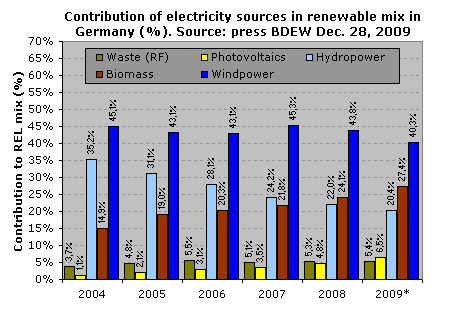
Graph
BDEW 4 - comparable diagram as in graph BDEW 3, but now
the share of the production of the option considered as a percentage of
total renewable production (all five options together) is presented. The
most striking is (a) the considerable loss of market share of hydropower
(not much structural new capacity possible [on land], and mostly already
realised a long time ago, hence as other options keep growing the share
of hydropower will decrease step by step). (b) the relatively high, somewhat
diminished share of windpower in the sustainable mix. And (c) the gradual
march ("increase of market share") of biomass and solar electricity
as well. The last one already has "taken" 6,5% of the renewable
electricity mix, with good growth perspective as costs for the production
of PV-modules keep on going downwards, and remaining, stepwise progress
in the increase of efficiency.
Grafiek
BDEW 4 - als grafiek 3, maar nu wordt het aandeel van
de productie van de betreffende hernieuwbare optie als percentage van
de totale hernieuwbare productie (alle vijf opties bij elkaar) weergegeven.
Meest opvallend is (a) de fors aan impact inboetende variant waterkracht
(weinig structurele bijbouw mogelijk [op land], en al lang geleden meeste
installaties geïmplementeerd, dus bij groeiend aanbod andere opties
aandeel stapsgewijs, van jaar tot jaar afnemend). (b) het relatief hoge,
iets afgenomen aandeel windenergie in de mix. En (c) de gestage opmars
("marktaandeel vergroting") van zowel biomassa als zonnestroom.
De laatste heeft al 6,5% van de hernieuwbare mix te pakken, met vooruitzicht
op flinke groei bij almaar voortgaande kostenreductie van zonnepanelen,
en blijvende, stapsgewijs voortschrijdende efficiëntie vergroting.
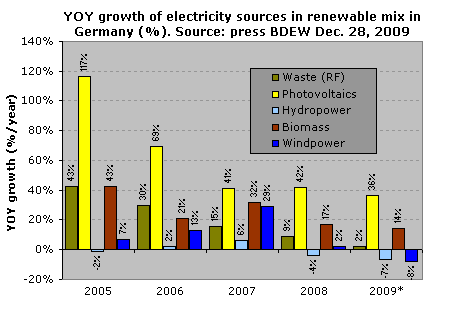
(growth of
electricity production as related to the previous year)
Graph
BDEW 5 - The relative growth of the kWh production of
the separate options on a year-to-year basis. An extensive (Dutch) analysis
you will again find in the article
of Jan. 11 2010. Solar electricity still has good yearly growth levels,
even in times of economic crisis and social turmoil.
Grafiek
BDEW 5 - De relatieve groei van de kWh productie van de
afzonderlijke opties van jaar tot jaar. Een uitgebreide bespreking bij
deze grafiek vindt u wederom in het artikel
van 11 januari 2010.
Links
http://www.bdew.de/
... Erneuerbare_erzeugten_16_Prozent_des_Stroms?open&ccm=250010
(bron van de getallen waarvan Polder PV de BDEW grafieken
heeft gemaakt, met name van het op deze pagina ter beschikking staande
pdf document)
http://tinyurl.com/ylf2ob4
(verkorte link naar BNA bronpagina van de capaciteitsgroei
van zonnestroom in Duitsland op basis van de bij het Bundesnetzagentur
aangemelde gegevens van alle eigenaren of uitbaters van nieuwe PV-systemen
per 1 januari 2009 die beroep willen doen op de wettelijk verplichte EEG
Einspeise Vergütungen van de regionale netbeheerders. Let op: volledigheid
van database wordt door sommigen in twijfel getrokken, o.a. door Photon)
Statistiek
data/statistical data:
©
Bundesverband der Energie-
und Wasserwirtschaft (BDEW)
© Bundesnetzagentur (BNA)
Uitwerking/additional
calculations and graph production: Polder
PV. Errors and miscalculations are the responsibility of Polder PV.
Please notify the
webmaster if you find any.
Webpagina
gepubliceerd dd. 11 januari 2010; toegevoegd BNA gegevens voor oktober
2009 op 17 januari 2010; toegevoegd BNA gegevens voor november 2009 op
4 februari 2010; toegevoegd BNA data voor december 2009 op 10 april 2010.
|
